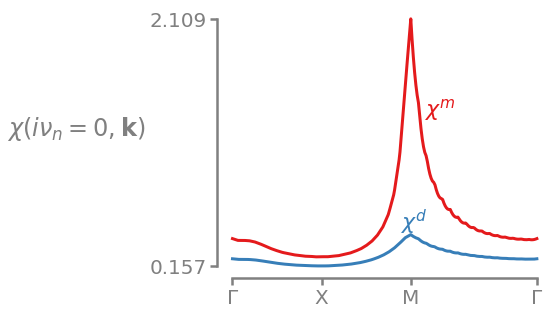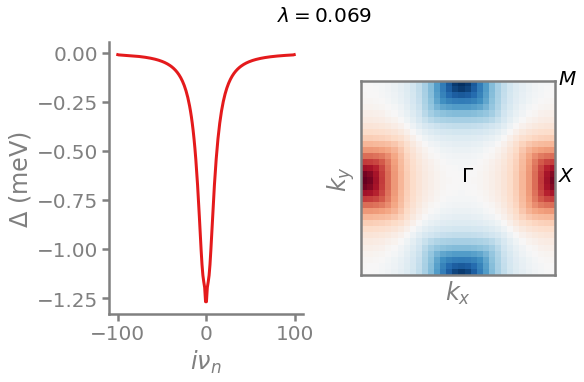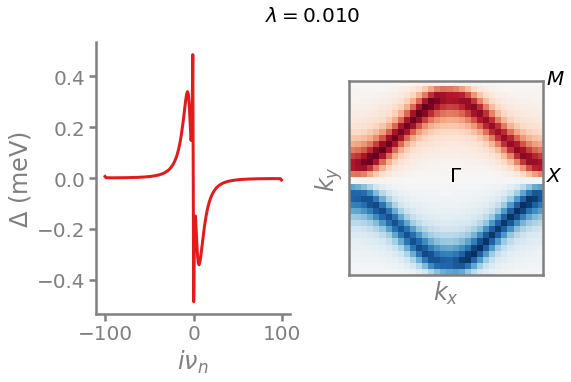Solving the linearized Eliashberg equation in the random phase approximation limit
In this notebook we will walk you through the steps of solving the linearized Eliashberg equation in the random phase approximation (RPA) limit. Make sure, that you have read the theory before reading further.
The steps are 1. Construct the density- and magnetic-susceptibilties in RPA 2. Construct the particle-particle vertex in RPA 3. Construct the symmetrizing functions 4. Solve the linearized Eliashberg equation
1. Construct the density- and magnetic-susceptibilties in RPA
First we need a model and in this example we use the 1-band square lattice.
[3]:
from triqs_tprf.tight_binding import create_square_lattice
square_lattice = create_square_lattice(norb=1, t=1.0)
Next we need the non-interacting one-particle Green’s function. For this we first create the dispersion relation on a mesh on the Brillouin zone.
[4]:
nk = 32
e_k = square_lattice.fourier(square_lattice.get_kmesh((nk, nk, 1)))
And then we solve the lattice dyson equation lattice_dyson_g0_wk for a specific fermionic Matsubara frequency mesh MeshImFreq to obtain the non-interacting one-particle Green’s function g0_wk.
[5]:
from triqs.gf import MeshImFreq
from triqs_tprf.lattice import lattice_dyson_g0_wk
wmesh = MeshImFreq(beta=10, S='Fermion', n_max=100)
g0_wk = lattice_dyson_g0_wk(mu=0, e_k=e_k, mesh=wmesh)
Next we solve for the density- and magnetic-susceptibilties in RPA by first constructing the bare bubble \(\chi_0\) imtime_bubble_chi0_wk
[6]:
from triqs_tprf.lattice_utils import imtime_bubble_chi0_wk
chi0_wk = imtime_bubble_chi0_wk(g0_wk, nw=100)
╔╦╗╦═╗╦╔═╗ ╔═╗ ┌┬┐┌─┐┬─┐┌─┐
║ ╠╦╝║║═╬╗╚═╗ │ ├─┘├┬┘├┤
╩ ╩╚═╩╚═╝╚╚═╝ ┴ ┴ ┴└─└
Two-Particle Response Function tool-box
beta = 10.0
nk = 1024
nw = 200
norb = 1
Approx. Memory Utilization: 0.01 GB
--> fourier_wk_to_wr
--> fourier_wr_to_tr
--> chi0_tr_from_grt_PH (bubble in tau & r)
--> chi_wr_from_chi_tr
--> chi_wk_from_chi_wr (r->k)
and then solving the RPA equations solve_rpa_PH for a Hubbard \(U\), a rank 4 numpy array.
[7]:
import numpy as np
from triqs_tprf.lattice import solve_rpa_PH
U = 1.0 * np.ones(shape=(1, 1, 1, 1), dtype=complex)
chi_d_wk = solve_rpa_PH(chi0_wk, -U) # Minus here for correct density RPA equation
chi_m_wk = solve_rpa_PH(chi0_wk, U)
Plotting this over a path through the high-symmetry points looks as follows.
[8]:
plot_chi(chi_m_wk, chi_d_wk)

2. Construct the particle-particle vertex in RPA
Now we have all the ingredients to build the particle-particle vertex in the RPA limit. In this example we limit us to the singlet particle-particle vertex for a symmetry constraint calculation of the Eliashberg equation.
\begin{align} \Gamma^{\mathrm{singlet}}(i\omega_n, \mathbf{q}) = 3\Phi^{\mathrm{m}}(i\omega_n, \mathbf{q}) - \Phi^{\mathrm{d}}(i\omega_n, \mathbf{q}) + \frac{1}{2} U^{\mathrm{d}} + \frac{3}{2} U^{\mathrm{m}} \, \end{align}
where
\begin{align} \Phi^{\mathrm{d/m}}(i\omega_n, \mathbf{q}) = U^{\mathrm{d/m}} \chi^{\mathrm{d/m}}(i\omega_n, \mathbf{q}) U^{\mathrm{d/m}} \,. \end{align}
For the 1-band case \(U^{\mathrm{d/m}}=U\) and we don’t have to take correct orbital ording in the products into account, which simplifies everything. But for generality we will show the process which also works for multi-orbital systems, where we first construct the density/magentic reducible ladder vertex \(\Phi^{\mathrm{d/m}}\) via construct_phi_wk.
[9]:
from triqs_tprf.lattice import construct_phi_wk
phi_d_wk = construct_phi_wk(chi_d_wk, U)
phi_m_wk = construct_phi_wk(chi_m_wk, U)
And then construct the singlet particle-particle vertex via construct_gamma_singlet_rpa.
[10]:
from triqs_tprf.eliashberg import construct_gamma_singlet_rpa
gamma_singlet = construct_gamma_singlet_rpa(U, U, phi_d_wk, phi_m_wk)
3. Construct the symmetrizing functions
By using the above \(\Gamma\) we must enforce the allowed \(SPOT\) symmetries of the superconducting gap \(\Delta\). Our 1-band model is by default even in orbital symmetry and by using the singlet \(\Gamma\) we are fixing the spin symmetry to odd. We are therefore left with two physical symmetry combinations.
Spin |
Parity (Momentum) |
Orbital |
Time (Frequency) |
|---|---|---|---|
odd |
even |
even |
even |
odd |
odd |
even |
odd |
We will solve for them individually, by constructing a symmetrizing function for each of them. We do this by taking enforce_symmetry and using functools.partial to specifiy the symmetries that we want.
Frequency: Even, Momentum: Even
[11]:
import functools
from triqs_tprf.symmetries import enforce_symmetry
variables = ["frequency", "momentum"]
symmetries = ["even", "even"]
symmetrize_freq_even_mom_even = functools.partial(enforce_symmetry, variables=variables, symmetries=symmetries)
Frequency: Odd, Momentum: Odd
[12]:
symmetries = ["odd", "odd"]
symmetrize_freq_odd_mom_odd = functools.partial(enforce_symmetry, variables=variables, symmetries=symmetries)
4. Solve the linearized Eliashberg equation
Now we have everything that we need to solve the linearized Eliashberg equation. We call the solve_eliashberg function with each of our symmetrize_fcts and solve for the first leading eigenvalue, gap pair (k=1).
[13]:
from triqs_tprf.eliashberg import solve_eliashberg
lambdas_freq_even_mom_even, deltas_freq_even_mom_even = solve_eliashberg(gamma_singlet, g0_wk, symmetrize_fct=symmetrize_freq_even_mom_even, k=1)
lambdas_freq_odd_mom_odd, deltas_freq_odd_mom_odd = solve_eliashberg(gamma_singlet, g0_wk, symmetrize_fct=symmetrize_freq_odd_mom_odd, k=1)
Plotting them shows that all symmetries are correct and that the gap with even frequency and odd momentum has the higher \(\lambda\) and is therefore leading.
[14]:
plot_delta(deltas_freq_even_mom_even[0], lambdas_freq_even_mom_even[0])

[15]:
plot_delta(deltas_freq_odd_mom_odd[0], lambdas_freq_odd_mom_odd[0])
